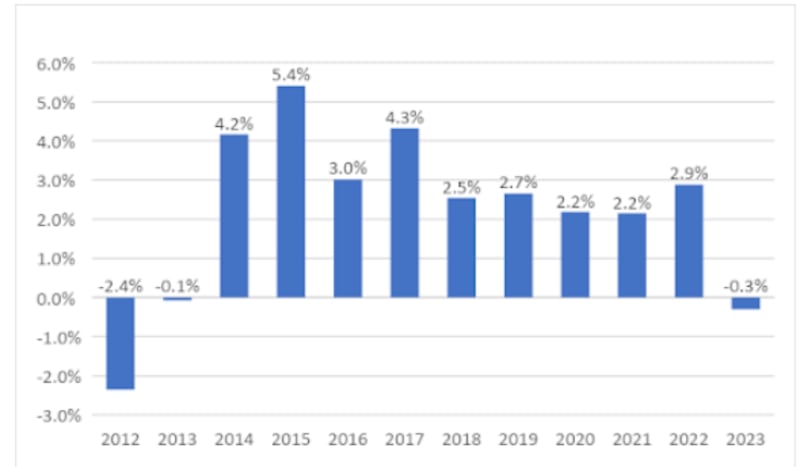Asking prices for homes in Ireland declined by 0.3 per cent in the first three months of the year, the first time that prices have fallen nationally between January and March since 2013. However, the latest Daft.ie housing market report indicates that despite some improvements, the pace of supply to the market continues to show signs of slowing.
Notwithstanding the marginal decline observed between the end of last year and March, the average asking price for a house in the first quarter was €308,497, still 2.7 per cent ahead of the same period in 2022.
Prices in Dublin were on average 0.4 per cent lower than in the final three months of 2022 and 0.5 per cent lower quarter-on-quarter in Cork. The decline was sharper in Waterford City and Galway City, where asking prices fell by 0.8 per cent and 1.5 per cent, while prices in Limerick City were stable quarter-on-quarter, the property website said.



Outside the cities, prices in Leinster and in Connacht-Ulster fell by roughly half a percentage point over the quarter, but rose in Munster by 0.6 per cent.
But while the number of houses available to buy stood at 13,000 on March 1st – up 30 per cent on the same date in 2022 – the stock of properties remains “significantly below” the 2019 average.
“That is still barely half the level of supply that prevailed before Covid-19,” said report author Ronan Lyons, associate professor of economics at Trinity College Dublin. “Between 2015 and 2019, when the market was tight in most parts of the country, there were an average of 25,000 homes to buy at any point in time.”
He said that the change in market conditions over the past year is “clear” from the figures, given that “a year ago, double-digit inflation in housing prices was still prevalent across much of the country”.
However, Mr Lyons said that “while demand has weakened,” largely due to shifting macroeconomic conditions, particularly rising interest rates and still-elevated rates of inflation in the wider economy, “the post-Covid recovery in supply also appears to be weakening, in both new and second-hand segments”.
While the supply of second-hand homes responds mostly to price, the supply of new homes responds to costs, he said. So as demand continues to soften as borrowing costs rise, asking prices could continue to fall and with them, the supply of second-hand homes to the market as homeowners have less incentive to sell. Equally, still-elevated construction costs are likely to dampen the supply of new houses.
Economists have also warned that despite an upward underlying trend in home build completions, new population estimates due later this year mean demand is likely to be revised upward.
Addressing the Oireachtas Committee on Budgetary Oversight last week, Kieran McQuinn, research professor at the Economic and Social Research Institute said: “This means that the demand for housing is likely to exceed the supply over the medium term. As a result, house price inflation along with increases in rents are likely to continue, albeit, in the case of house prices, at a slower pace than was the case in 2022.”
The outlook for housing completions is also looking increasingly grim for this year.
More than 9,100 dwellings were completed in the final three months of 2022, an increase of 31.4 per cent on the same period in 2021, bringing to almost 30,000 the total number of units finished last year, the Banking and Payments Federation of Ireland said in a recent report.
But while the 2022 total represented a 45 per cent jump from 2021, when the construction sector was still constrained by Covid-related public health restrictions, the number of completions is expected to slip back towards 2019 levels this year.
A separate report by analysts from Goodbody Stockbrokers earlier this month also warned that the supply of housing is expected to remain “stable” this year. Housing starts are “flatlining” with forecast output to remain “substantially below Ireland’s estimated housing need”.
![Report author Ronan Lyons said that 'while demand has weakened[...] the post-covid recovery in supply also appears to be weakening, in both new and second-hand segments.' Photograph: PA Images](https://www.irishtimes.com/resizer/v2/I3FNPEKKEKVLWULA4A4FW2JQWI.jpg?auth=edf5ef9b17ae582c9ee88ffa408a615d0739fb7afcc8e480916fbf4a123b933f&smart=true&width=1024&height=683)













